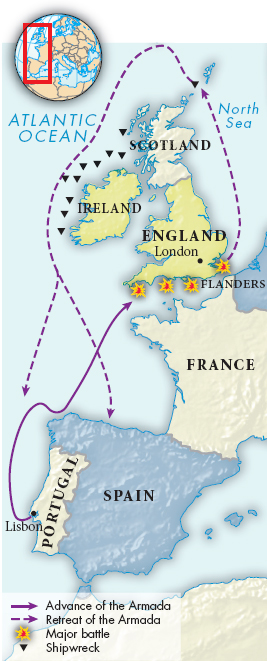Upholding Protestantism in England
In the short reign of Henry’s sickly son, Edward VI (r. 1547–

The equally brief reign of Mary Tudor (r. 1553–
At the start of Elizabeth’s reign, sharp differences existed in England. On the one hand, Catholics wanted a Roman Catholic ruler. On the other hand, a vocal number of returning exiles wanted all Catholic elements in the Church of England eliminated. The latter, because they wanted to “purify” the church, were called “Puritans.”
Shrewdly, Elizabeth chose a middle course between Catholic and Puritan extremes. Working through Parliament, she ordered church and government officials to swear that she was supreme in matters of religion as well as politics, required her subjects to attend services in the Church of England or risk a fine, and called for frequent preaching of Protestant ideas. She did not interfere with people’s privately held beliefs, however. The Anglican Church, as the Church of England was called, moved in a moderately Protestant direction.
Toward the end of the sixteenth century, Elizabeth’s reign was threatened by European powers attempting to re-
Philip prepared a vast fleet to sail from Lisbon to Flanders, where a large army of Spanish troops was stationed because of religious wars in the Netherlands (see page 404). The Spanish ships were to escort barges carrying some of the troops across the English Channel to attack England. On May 9, 1588, the Spanish Armada sailed from Lisbon harbor. It met an English fleet in the Channel before it reached Flanders. A combination of storms and squalls; spoiled food and tainted water; inadequate Spanish ammunition; and, to a lesser extent, English fire ships that caused the Spanish to scatter gave England the victory.
The battle in the English Channel has frequently been described as one of the decisive battles in world history. In fact, it had mixed consequences. Spain soon rebuilt its navy and the war between England and Spain dragged on for years. Yet the defeat of the Spanish Armada prevented Philip II from reimposing Catholicism on England by force. In England, the victory contributed to a David and Goliath legend that enhanced English national sentiment.